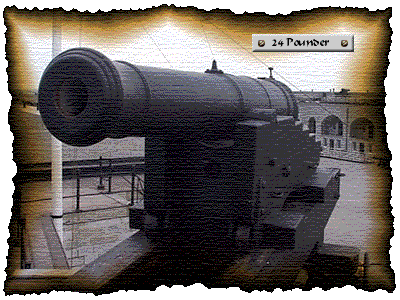
The word "gun" is loosely used, around the world, to apply to all artillery. It should, however, be applied to one particular type of ordnance.
Guns refer to ordnances of 14 calibres and upwards (in length). Calibre means the diameter of the bore. Guns have trunnions near the middle of the barrel — a little in front of the centre of gravity. A trunnion is a piece of metal attached to the cylindrical barrel of the gun so that it can rest in the wooden carriage. This allows the barrel to be pointed up and down so that the elevation of the shot is correct.

Shot guns are used for firing either shot or shell at very low angles over the greatest possible distance with a fixed charge. They combine the longest range with the greatest hitting power.
Shot guns are distinguished by the weight of the solid cast-iron shot which they fire and the weight of the gun. When a soldier points out a 24-pounder cast-iron gun of 50 cwt. (carat weight), the 24 pounds refers to the weight of the shot that is fired out of the gun. The 50 cwt. refers to the actual weight of the gun. The weight of the actual gun is not that important and some guns differed as much as a hundred pounds.
The speed (velocity) at which the shot comes out of the muzzle was important for obtaining long range. However, the remaining velocity at the target was also important because it determined the "hitting power" of a solid projectile. If the shot did not land with any speed, it could not do any damage.
When these guns had a smooth-bore, the projectiles had a poor ballistic performance. This means that they were very unsteady while travelling through the air. The farther they travelled, the more rapidly they slowed down, so that the projectiles of lighter guns failed to give much hitting power at ranges of more than 1,300 yards.
In order to obtain longer ranges, it was necessary to increase the firing angle which, in turn, increased the projectile’s angle of arrival. This meant that a projectile had to be shot high into the air, so that it came down hard on the enemy's head. Shot tended to bury itself harmlessly in the ground if the angle of arrival was too steep.
For these reasons and partly because direct fire at longer ranges could not be done with the naked eye, the smooth-bore guns were rarely fired on land with an elevation of more than three or four degrees, and its carriage was designed accordingly. For a 24-pounder gun of 50 cwt., a charge of eight pounds and an elevation of four degrees would give a range of 1,700 yards.
During the nineteenth century, the amount of charge (gunpowder) needed to blast a shot out of a gun was nearly always a third of the shot weight, although smaller guns such as the 6 and 9-pounders used charges of a quarter of the shot weight.
The barrel of a gun was made out of cast iron or brass. Brass barrels were much lighter than cast-iron barrels and, hence, were used on field carriages. However, the barrels heated up much faster and they could not maintain a sustained rate of fire for as long a period as an iron gun.
![]()